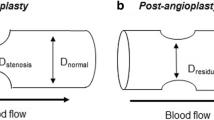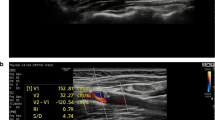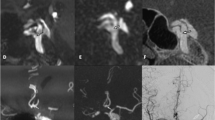Abstract
Purpose
Angiographic assessment of carotid cavernous fistulas (CCFs) can be complex. Our purpose was to examine whether the use of parametric color coding in the postprocessing of DSA series is advantageous in the evaluation of CCFs.
Methods
We enrolled 16 patients with angiographically proven CCFs. Endovascular treatment was performed in 14 cases. For postprocessing of digital subtraction angiography (DSA) series, a newly implemented algorithm of parametric color coding was used, turning sequential images of two-dimensional (2D)-DSA series into a single color-coded image. Angiographic data of initial, interventional, and postinterventional 2D-DSA series were compared with color-coded images. Whether parametric color coding could facilitate evaluation of fistula architecture and provide a more precise estimation of fistula venous drainage patterns as well as whether flow analysis could reveal objective changes during and after treatment were investigated.
Results
In 56 % of the cases, parametric color coding was observed to facilitate visualization of fistula angioarchitecture. Estimation of fistula drainage flow patterns was considered to be improved in 31 % of the cases. For assessment of hemodynamic changes during and after treatment, parametric color coding was assumed to be helpful in 21 % of the cases, especially because revealing flow changes that were not visible on 2D-DSA series were now visible.
Conclusions
Parametric color coding is a fast application tool that might provide additional support in the angiographic evaluation of CCFs. Visualization of complex fistula architecture could be facilitated, and flow analysis might improve assessment of venous drainage patterns, thereby increasing overall diagnostic confidence. During and after treatment, hemodynamic changes that were not visible on 2D-DSA series could now be depicted.
Zusammenfassung
Ziel
Die angiografische Beurteilung von Karotis-cavernosus Fisteln kann komplex sein. Unser Ziel war es zu prüfen, ob eine parametrische Farbkodierung in der Nachverarbeitung der DSA einen Benefit für die Evaluierung von Karotis-cavernosus Fisteln bringt.
Methoden
Es wurden 16 Patienten mit angiografisch nachgewiesener Karotis-cavernosus Fistel eingeschlossen. Eine endovaskuläre Behandlung wurde in 14 Fällen durchgeführt. In der DSA-Nachverarbeitung wurde ein neu implementierter Algorithmus der parametrischen Farbkodierung verwendet, um die sequentiellen Bilder der 2D-DSA Serien in ein einziges, farbkodiertes Bild zu wandeln. Die angiografischen Daten der initialen, der interventionellen und der postinterventionellen 2D-DSA Serien wurden jeweils mit den farbkodierten Bildern verglichen. Es wurde bewertet, ob die parametrische Farbkodierung die Evaluierung der Fistelarchitektur erleichtern und eine präzisere Einschätzung der venösen Drainagemuster lieferen könnte. Zudem wurde untersucht, ob eine Flussanalyse vielleicht objektive Veränderungen während und nach einer Behandlung aufzeigen kann.
Ergebnisse
In 56 % der Fälle wurde die parametrische Farbkodierung als Erleichterung hinsichtlicher der Visualisierung der Angioarchitektur der Fistel angesehen. Die Einschätzung der venösen Drainagemuster der Fistel wurde in 31 % der Fälle als verbessert gewertet. Bezüglich der Einschätzung von hämodynamischen Veränderungen während und nach einer Behandlung wurde die parametrische Farbkodierung in 21 % der Fälle als hilfreich eingestuft, insbesondere weil Flussänderungen aufgezeigt werden konnten, die auf 2D-DSA Serien nicht erkennbar waren.
Schlussfolgerungen
Die parametrische Farbkodierung ist ein schnell anwendbares Hilfsmittel, das eine zusätzliche Unterstützung in der angiografische Aufarbeitung von Karotis-cavernosus Fisteln liefern könnte. Die Visualisierung einer komplexen Fistelarchitektur könnte hiermit erleichtert werden und die Flussanalyse dürfte die Einschätzung venöser Drainagemuster verbessern, wodurch folglich die diagnostische Sicherheit erhöht wird. Während und nach einer Behandlung könnten Veränderungen der Hämodynamik entdeckt werden, die auf 2D-DSA Serien nicht abgegrenzbar sind.




Similar content being viewed by others
References
Leonard TJ, Moseley IF, Sanders MD. Ophthalmoplegia in carotid cavernous sinus fistula. Br J Ophthalmol. 1984;68:128–34.
Fujitani A, Hayasaka S. Concurrent acute angle-closure glaucoma, choroidal detachment and exudative retinal detachment in a patient with spontaneous carotid cavernous fistula. Ophthalmologica. 1995;209:220–2.
Choi HY, Newman NJ, Biousse V, et al. Serous retinal detachment following carotid cavernous fistula. Br J Ophthalmol. 2006;90:1440–4.
Barrow DL, Spector RH, Braun IF, et al. Classification and treatment of spontaneous carotid-cavernous sinus fistulas. J Neurosurg. 1985;62:248–56.
Higashida RT, Halbach VV, Tsai FY, et al. Interventional neurovascular treatment of traumatic carotid and vertebral artery lesions: results in 234 cases. AJR Am J Roentgenol. 1989;153:577–82.
Luo CB, Teng MM, Yen DH, et al. Endovascular embolization of recurrent traumatic carotid-cavernous fistulas managed previously with detachable balloons. J Trauma. 2004;56:1214–20.
Gupta AK, Purkayastha S, Krishnamoorthy T, et al. Endovascular treatment of direct carotid cavernous fistulae: a pictorial review. Neuroradiology. 2006;48:831–9.
Wang W, Li YD, Li MH, et al. Endovascular treatment of post-traumatic direct carotid-cavernous fistulas: a single-center experience. J Clin Neurosci. 2011;18:24–8.
Kirsch M, Henkes H, Liebig T, et al. Endovascular management of dural carotid-cavernous sinus fistulas in 141 patients. Neuroradiology. 2006;48:486–90.
Meyers PM, Halbach VV, Dowd CF, et al. Dural carotid cavernous fistula: definitive endovascular management and long-term follow-up. Am J Ophthalmol. 2002;134:85–92.
Zaidat OO, Lazzaro MA, Niu T, et al. Multimodal endovascular therapy of traumatic and spontaneous carotid cavernous fistula using coils, n-BCA, Onyx and stent graft. J Neurointerv Surg. 2011;3:255–62.
Debrun GM. Angiographic workup of a carotid cavernous sinus fistula (CCF), or what information does the interventionalist need for treatment? Surg Neurol. 1995;44:75–9.
Ahmed AS, Deuerling-Zheng Y, Strother CM, et al. Impact of intra-arterial injection parameters on arterial, capillary, and venous time-concentration curves in a canine model. AJNR Am J Neuroradiol. 2009;30:1337–41.
Strother CM, Bender F, Deuerling-Zheng Y, et al. Parametric color coding of digital subtraction angiography. AJNR Am J Neuroradiol. 2010;3:919–24.
Conflict of Interest
The authors declare that there is no actual or potential conflict of interest in relation to this article.
Author information
Authors and Affiliations
Corresponding author
Rights and permissions
About this article
Cite this article
Gölitz, P., Struffert, T., Lücking, H. et al. Parametric Color Coding of Digital Subtraction Angiography in the Evaluation of Carotid Cavernous Fistulas. Clin Neuroradiol 23, 113–120 (2013). https://doi.org/10.1007/s00062-012-0184-8
Received:
Accepted:
Published:
Issue Date:
DOI: https://doi.org/10.1007/s00062-012-0184-8




